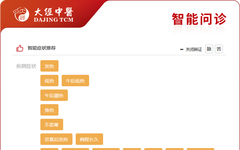 Young people often hear news about working late, excessive fatigue, and even sudden death. While this is heartbreaking, it serves as a reminder for workers to seek medical attention promptly when experiencing discomfort. The young patient in today’s case also developed physical discomfort and persistent internal injury fever after excessive fatigue.Internal injury fever refers to a condition where the cause is internal injury, leading to dysfunction of the organs, deficiency of Qi, blood, Yin, and Yang as the fundamental pathogenesis, with fever as the main clinical manifestation.Generally, the onset is gradual, the course is prolonged, and the intensity of fever varies, but low-grade fever is common, or the patient feels feverish without an actual increase in body temperature.The pathogenesis of internal injury fever can be broadly categorized into deficiency and excess types.Deficiency:Caused by Qi stagnation transforming into fire, blood stasis, and phlegm-damp accumulation, which belong to the excess type. The basic pathogenesis involves the stagnation of Qi, blood, and dampness, leading to heat generation and fever.Excess:Caused by insufficient middle Qi, blood deficiency, Yin essence deficiency, and Yang Qi deficiency, which belong to the deficiency type. The basic pathogenesis involves deficiency of Qi, blood, Yin, and Yang, or insufficient Yin and blood, leading to Yang not restraining Yin, water not nourishing fire, and excessive Yang Qi causing fever, or due to insufficient middle Qi, internal generation of Yin fire, or Yang Qi deficiency leading to external floating Yang causing fever.Below, I would like to share a case of a fever patient I treated, hoping to provide some insights for everyone encountering similar patients in clinical practice.
Young people often hear news about working late, excessive fatigue, and even sudden death. While this is heartbreaking, it serves as a reminder for workers to seek medical attention promptly when experiencing discomfort. The young patient in today’s case also developed physical discomfort and persistent internal injury fever after excessive fatigue.Internal injury fever refers to a condition where the cause is internal injury, leading to dysfunction of the organs, deficiency of Qi, blood, Yin, and Yang as the fundamental pathogenesis, with fever as the main clinical manifestation.Generally, the onset is gradual, the course is prolonged, and the intensity of fever varies, but low-grade fever is common, or the patient feels feverish without an actual increase in body temperature.The pathogenesis of internal injury fever can be broadly categorized into deficiency and excess types.Deficiency:Caused by Qi stagnation transforming into fire, blood stasis, and phlegm-damp accumulation, which belong to the excess type. The basic pathogenesis involves the stagnation of Qi, blood, and dampness, leading to heat generation and fever.Excess:Caused by insufficient middle Qi, blood deficiency, Yin essence deficiency, and Yang Qi deficiency, which belong to the deficiency type. The basic pathogenesis involves deficiency of Qi, blood, Yin, and Yang, or insufficient Yin and blood, leading to Yang not restraining Yin, water not nourishing fire, and excessive Yang Qi causing fever, or due to insufficient middle Qi, internal generation of Yin fire, or Yang Qi deficiency leading to external floating Yang causing fever.Below, I would like to share a case of a fever patient I treated, hoping to provide some insights for everyone encountering similar patients in clinical practice.
1
Initial Diagnosis: Recurrent Fever After Fatigue, Lasting for a Month
On September 17 of this year, a young female patient presented, stating that she developed a fever after working overtime a month ago, with the highest temperature exceeding 39°C. Initially, she was treated for a “cold” at a nearby clinic, and after a week, her fever symptoms improved, and her temperature decreased. However, she still experienced low-grade fever daily, with a temperature around 37.5°C, lasting for 5-6 hours, typically occurring in the afternoon and evening, with no fever in the morning.To find the cause of the prolonged low fever, the patient underwent tests for tuberculosis, viral infections, and brucellosis at a local hospital, all of which returned normal results. She also took antibiotics and antipyretics, but with no effect. After being referred by a friend, she came to my clinic for treatment.Upon arrival, the patient appeared fatigued, with a pale complexion, pale lips, reduced appetite, loose stools, afternoon low fever, tidal fever, cold extremities, pale tongue, white coating, and a weak, large pulse.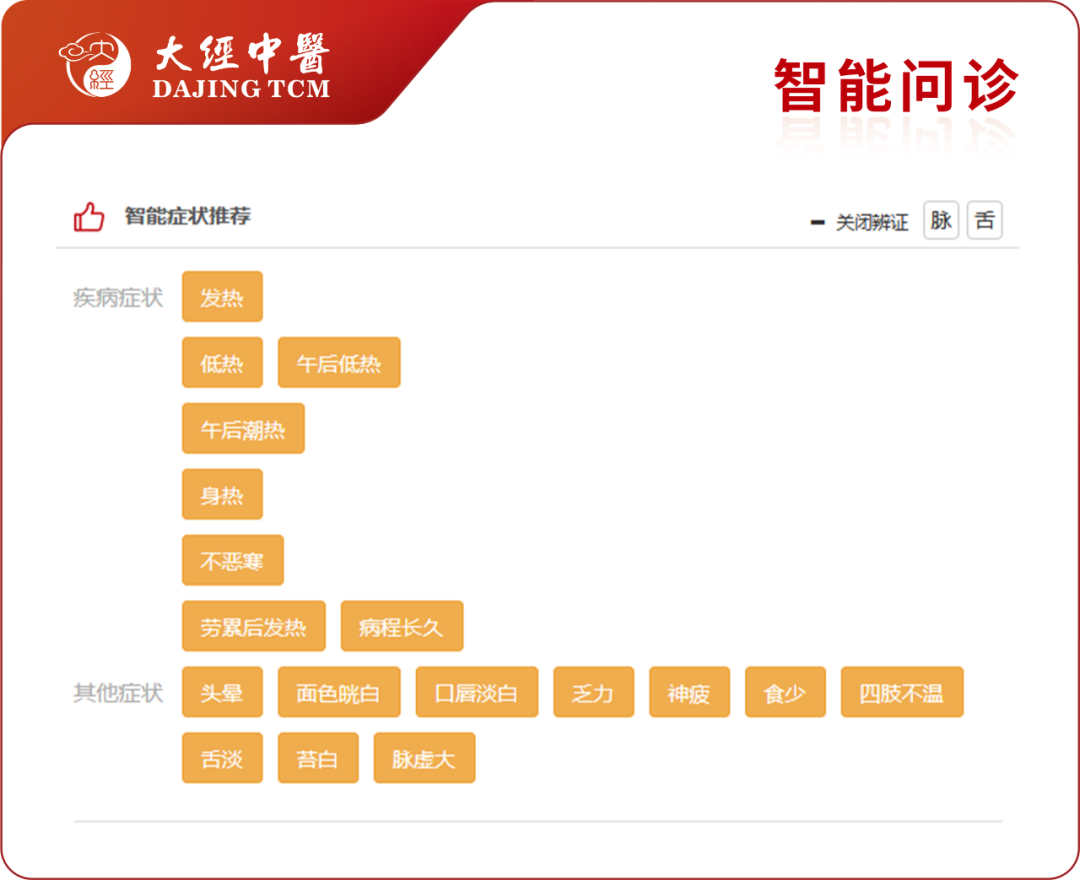 I entered the above symptoms and signs into the TCM intelligent diagnostic system, and the highest recommendation was the experience formula of Master Zhang Jingren for treating internal injury fever, with the treatment principle of nourishing the heart and spleen, and gently clearing heat. The system also recommended slightly lower-ranked treatment experiences from textbooks and guidelines, as well as other renowned TCM practitioners’ experiences, but most experiences identified deficiency patterns, primarily focusing on tonifying Qi and strengthening the spleen, and gently clearing heat. Based on the patient’s symptom characteristics, I adopted the highest-recommended experience from Master Zhang Jingren.
I entered the above symptoms and signs into the TCM intelligent diagnostic system, and the highest recommendation was the experience formula of Master Zhang Jingren for treating internal injury fever, with the treatment principle of nourishing the heart and spleen, and gently clearing heat. The system also recommended slightly lower-ranked treatment experiences from textbooks and guidelines, as well as other renowned TCM practitioners’ experiences, but most experiences identified deficiency patterns, primarily focusing on tonifying Qi and strengthening the spleen, and gently clearing heat. Based on the patient’s symptom characteristics, I adopted the highest-recommended experience from Master Zhang Jingren.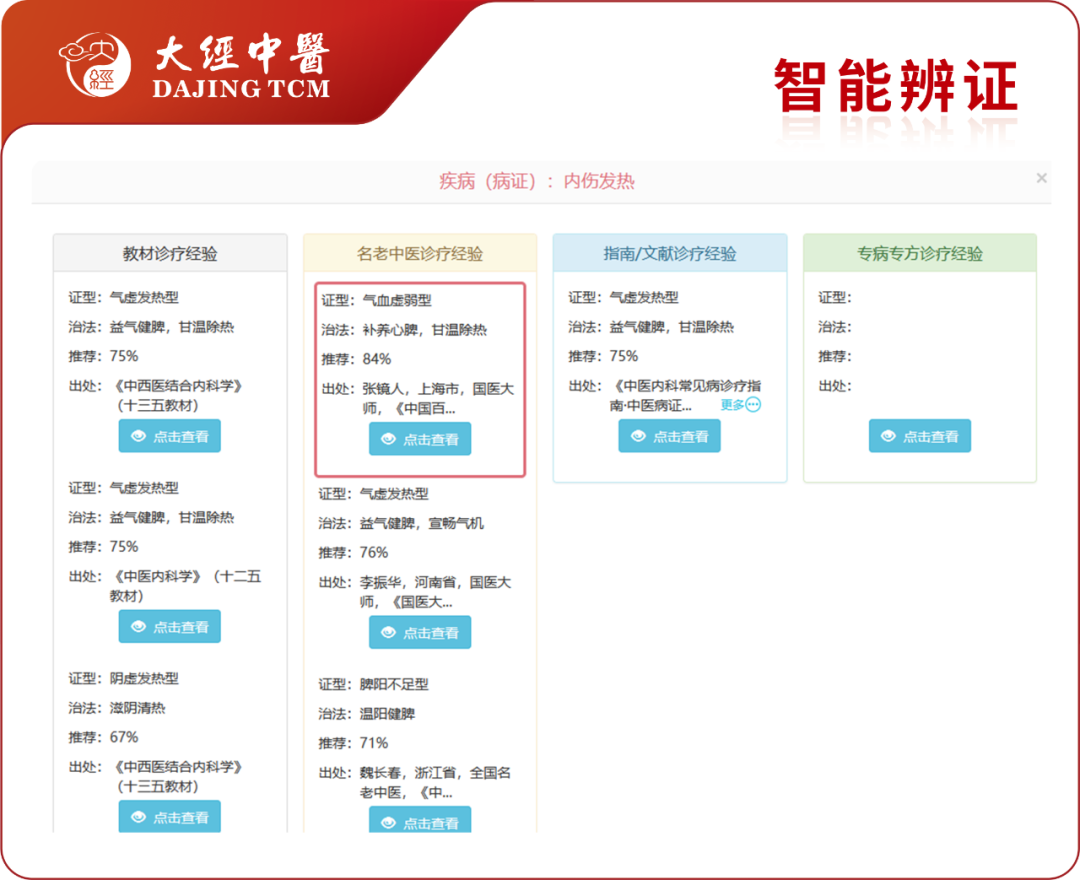 According to Master Zhang’s experience, this patient was diagnosed with Qi deficiency and blood weakness type, and the treatment principle was to nourish the heart and spleen, and gently clear heat. The prescription used was Bu Zhong Yi Qi Tang (Tonify the Middle and Augment the Qi Decoction) combined with Gui Pi Tang (Restore the Spleen Decoction) with modifications. I ultimately prescribed the following and advised the patient to avoid cold and raw foods and to rest.
According to Master Zhang’s experience, this patient was diagnosed with Qi deficiency and blood weakness type, and the treatment principle was to nourish the heart and spleen, and gently clear heat. The prescription used was Bu Zhong Yi Qi Tang (Tonify the Middle and Augment the Qi Decoction) combined with Gui Pi Tang (Restore the Spleen Decoction) with modifications. I ultimately prescribed the following and advised the patient to avoid cold and raw foods and to rest.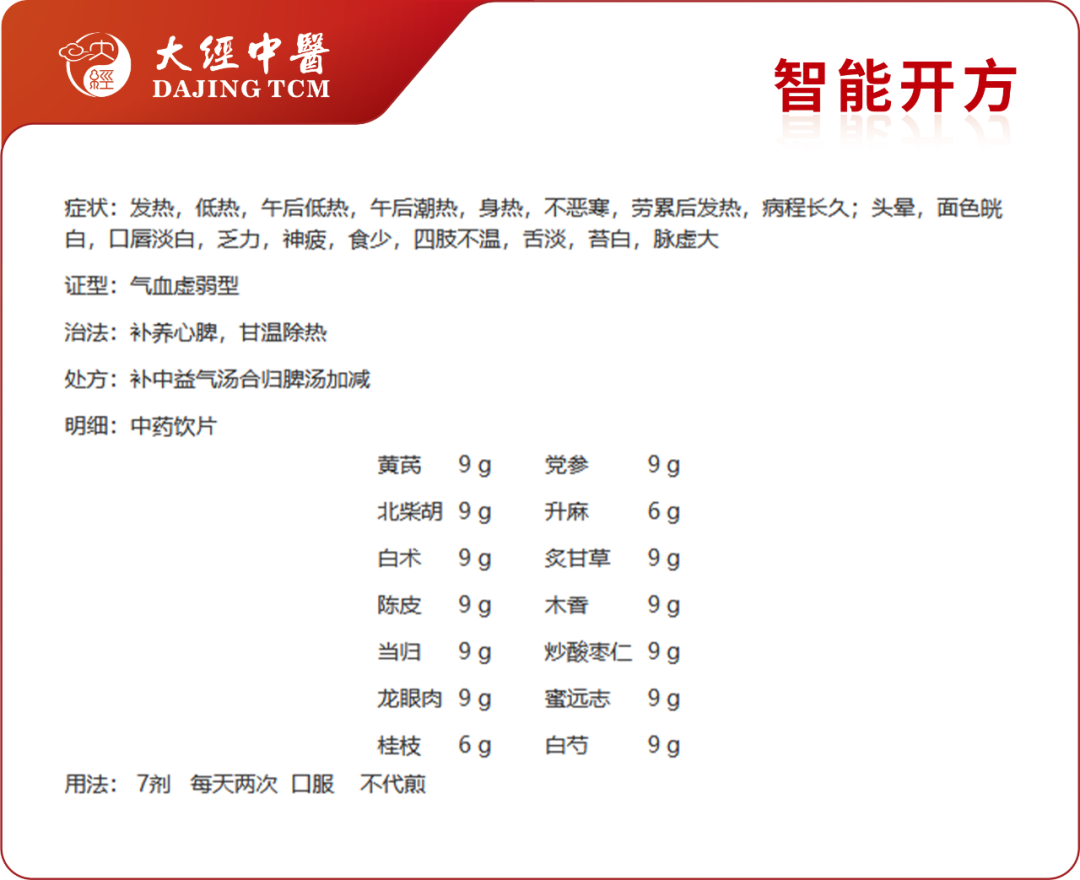
Prescription Explanation
The prescription includes Huang Qi (Astragalus), Dang Shen (Codonopsis), Bai Zhu (Atractylodes), and Zhi Gan Cao (Honey-fried Licorice) to tonify the spleen and augment Qi; Dang Gui (Angelica), Bai Shao (White Peony), Long Yan Rou (Longan), Suan Zao Ren (Sour Jujube Seed), and Yuan Zhi (Polygala) to nourish blood and calm the heart; Chai Hu (Bupleurum), Sheng Ma (Cimicifuga), Chen Pi (Tangerine Peel), Mu Xiang (Aucklandia), and Gui Zhi (Cinnamon Twig) to tonify Qi and raise Yang; The entire formula works to nourish the heart and spleen, augment Qi and blood, and gently clear heat.
2
Second Diagnosis: Improvement in Fatigue, Reduced Fever Duration
On September 24, the patient returned for a follow-up, reporting that after taking the medicine, she felt much better, with significant improvement in fatigue and weakness symptoms, and still experiencing fever in the afternoon, with a measured temperature around 37.2 degrees Celsius, lasting about 2 to 3 hours.This indicates that the method of tonifying Qi and nourishing blood, and gently clearing heat is effective. I added Jiang Can (Silkworm) 6g to enhance the dispersing wind and clearing heat effect, and continued treatment for another week.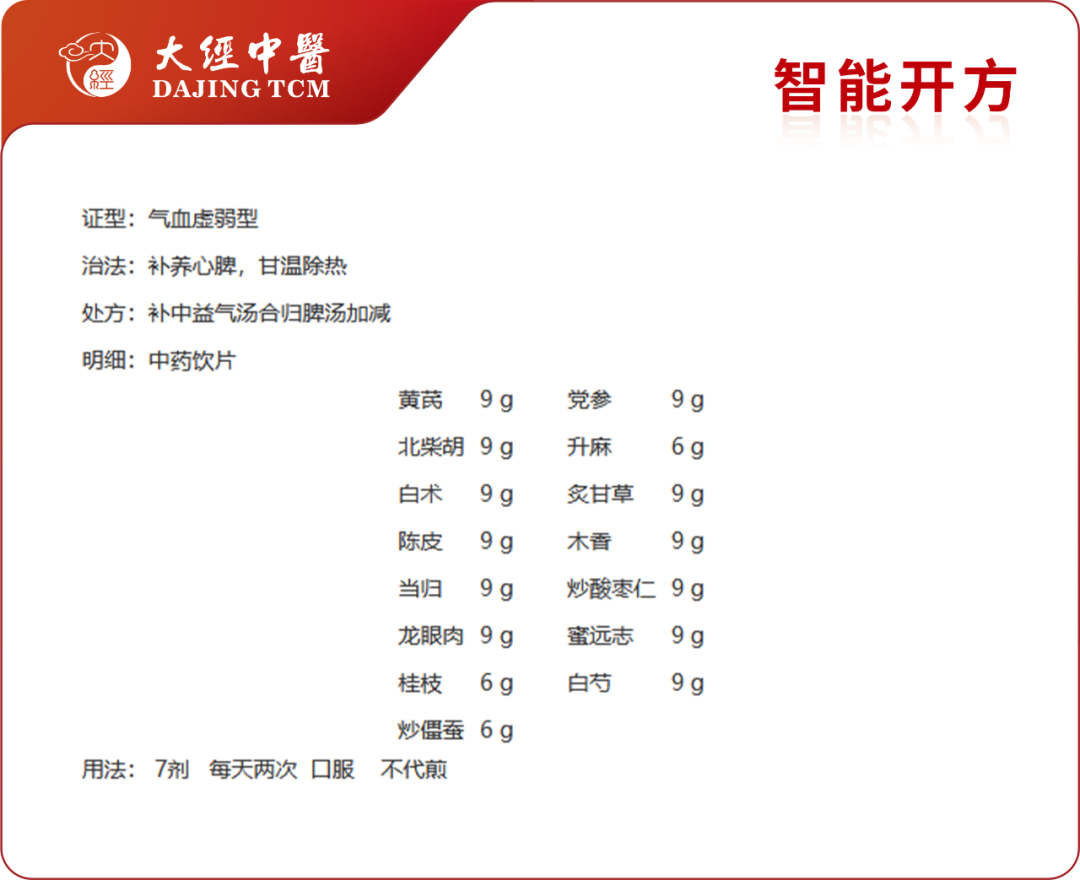
3
Third Diagnosis: Normal Temperature, Good Spirits
On October 1, the patient reported that after taking the medicine, her mental state improved significantly, and her temperature was basically normal, with a subjective feeling of heat in the afternoon, but measured temperature below 37 degrees Celsius. The original prescription was adjusted, with the dosage of Suan Zao Ren, Long Yan, and Yuan Zhi continued for another week for consolidation treatment.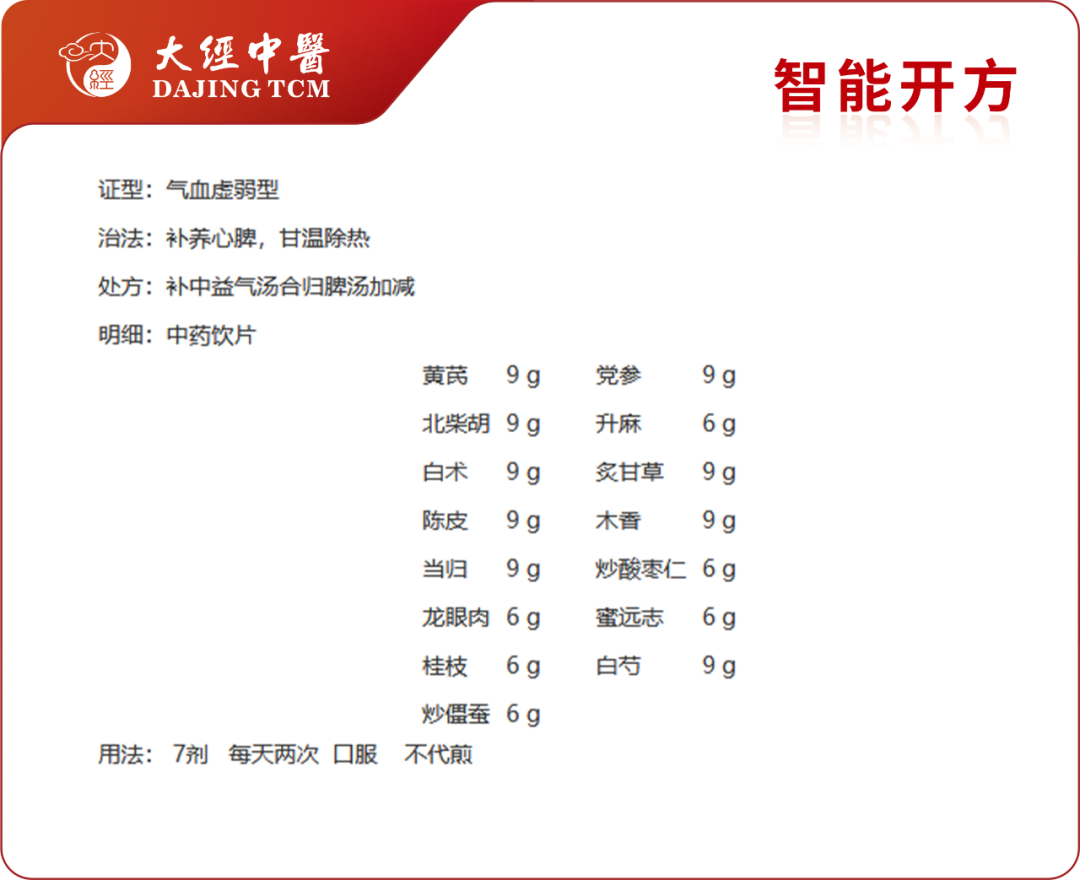
Post-Diagnosis Follow-Up
After three weeks of treatment, the online follow-up indicated that the patient was satisfied with the treatment results, with fever resolved, fatigue, weakness, and dizziness symptoms alleviated, and signs such as pale complexion and pale lips improved. I advised the patient to avoid overexertion, pay attention to rest, and she could take Bu Zhong Yi Qi Wan (Pill to Tonify the Middle and Augment Qi) for two weeks to consolidate the effect.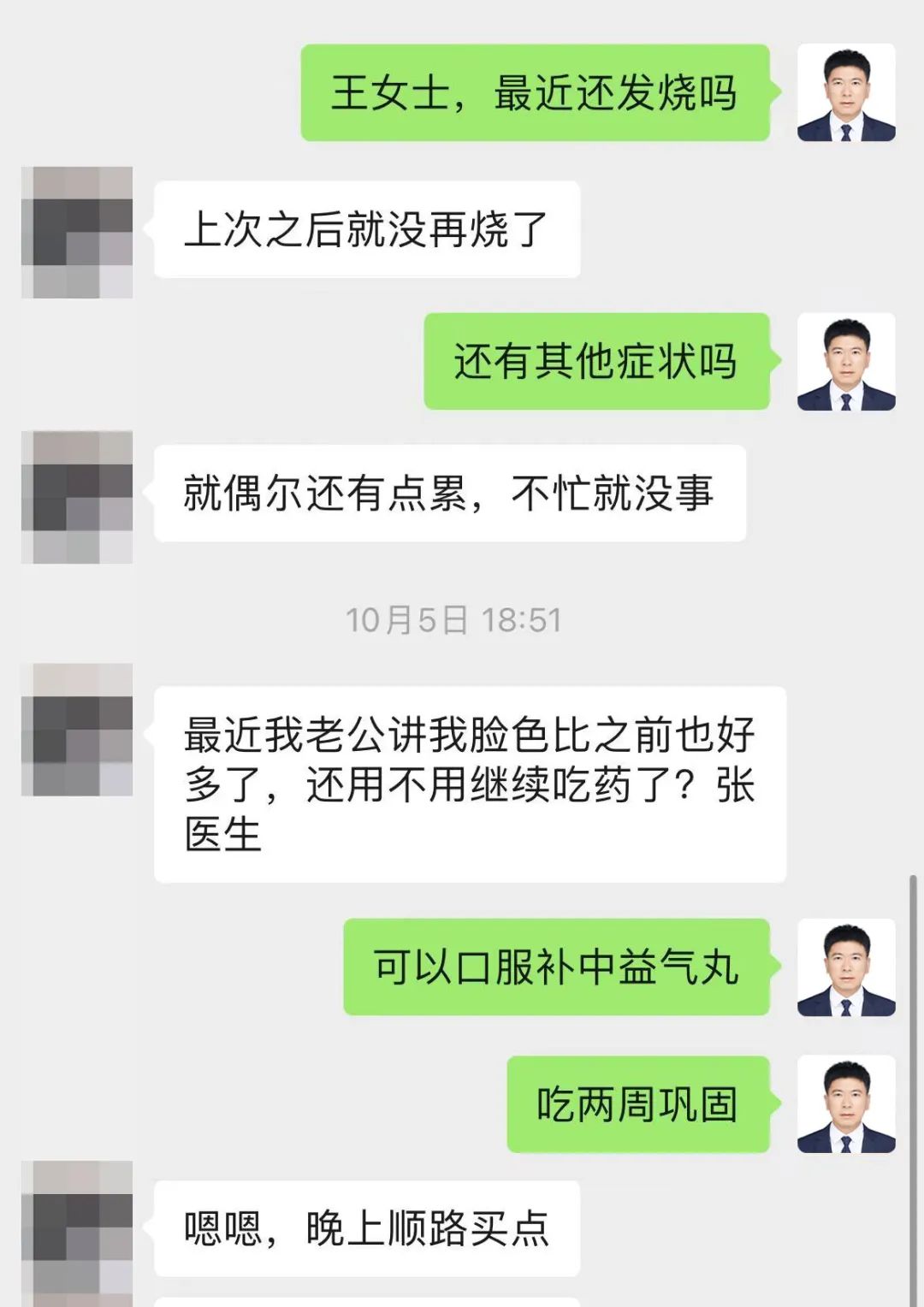
Remarks
From the perspective of Western medicine, it is difficult to find the cause of fever in cases of internal injury fever, and thus treatment is also challenging.TCM treatment for internal injury fever can be adjusted based on the dysfunction of the organs and the deficiency of Qi, blood, Yin, and Yang.Excess heat should be cleared, while deficiency heat should be tonified, and targeted treatment methods should be adopted according to the different symptoms and pathogenesis.For excess cases, the focus should be on resolving stagnation, invigorating blood, and eliminating dampness, with appropriate combinations to clear heat; for deficiency cases, the focus should be on tonifying Qi, nourishing blood, nourishing Yin, and warming Yang. In cases of Yin deficiency fever, appropriate combinations of herbs to clear deficiency heat can be used, while others should primarily focus on tonification. For mixed deficiency and excess cases, both aspects should be considered. As stated in the “Complete Book of Fire Syndromes” by Jingyue: “Excess heat should be drained, deficiency heat should be tonified, this is the principle. However, if there is deficiency within excess, treatment should primarily focus on tonification, but must also include some clearing; if there is excess within deficiency, treatment should primarily focus on clearing, but must also include some tonification.” One must not simply use dispersing and bitter-cold herbs upon encountering fever. In cases of internal injury fever, dispersing easily consumes Qi and injures Yin, while bitter-cold can easily harm the spleen and stomach, leading to prolonged or aggravated conditions.This patient has a history of fatigue, pale complexion, pale lips, fatigue, weakness, reduced appetite, pale tongue with white coating, and a weak, large pulse.This is caused by deficiency of both heart and spleen, lack of transformation and generation, and weakness of Qi and blood, leading to persistent fever. By tonifying the spleen and nourishing the heart, augmenting Qi and nourishing blood, the Yang Qi rises, and when the original Qi is strong, the Yin fire descends, and the fever subsides. [Medical Guidance and Disease Consultation] Please scan the QR code aboveThis case is for medical experience exchange and sharing only and should not be used as a basis for treatment of this disease. If you feel unwell, please seek professional medical help!
[Medical Guidance and Disease Consultation] Please scan the QR code aboveThis case is for medical experience exchange and sharing only and should not be used as a basis for treatment of this disease. If you feel unwell, please seek professional medical help!
众
ZHONG YUN
允
 Yun Cheng Du Xing | With Great ExpectationsZhong Yun Tang Wisdom TCM Internet ClinicAddress: 126 Ding Shan Da Jie, Jiangbei New District, Nanjing, Jiangsu ProvinceNanjing International Health City, Building 1AConsultation Phone: 025-58162969
Yun Cheng Du Xing | With Great ExpectationsZhong Yun Tang Wisdom TCM Internet ClinicAddress: 126 Ding Shan Da Jie, Jiangbei New District, Nanjing, Jiangsu ProvinceNanjing International Health City, Building 1AConsultation Phone: 025-58162969

